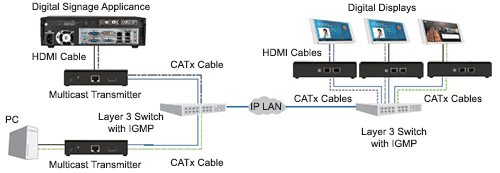Navigation |
AV over IP DistributionAV over IP DistributionIP-based distribution technologies use transmitters and receivers to extend signals over a TCP/IP network (a LAN or even a WAN, for instance). Oftentimes, they’re called IP streamers when used with codecs. But, when choosing one, be sure you’re not looking at the consumer-grade devices for streaming video in small office applications; be sure it’s a professional-grade multicasting product.  These sophisticated extenders use CATx cabling infrastructure, but in comparison to standard non-networked CATx extenders, they multicast data over an active Ethernet network. They do this by packetizing media streams for delivery over an IP-based network, so source content can be delivered anywhere you have Ethernet wiring. By leveraging existing IP network connections to distribute multimedia content, businesses can avoid running expensive dedicated links from a back room to digital signage in lobbies or other public areas. Plus, the video is a lot less susceptible to interference, image skew, and compromised resolution. Compression makes it possible to run the signal over longer runs — and compression does not have to mean low-quality video. Compressions may be lossy or lossless. The IP-based extension methods we’re discussing use visually lossless compression with algorithms that make it possible to run Full HD video over the LAN without any visual loss in quality. They may even simulcast video and audio synchronously so there’s no latency, feature QoS prioritization and bandwidth-management controls, and the ability to use bidirectional (two-way) serial signals to query a remote display to, for example, shut it down and power it on or gather performance data. What’s more, the system you choose may even support bidirectional serial connections for use with interactive touchscreens. Also, they may or may not support existing networking standards. This is important if you need extra distance in your distribution application. If they do support Ethernet standards, you can extend video through networking switches to get extra-long distances, beyond the specified cabling distances of 100 meters per the Ethernet standard.Find out more about our HDMI over IP Distribution solution. Because IP-based extenders are based on standardized Ethernet protocols, you can even use media converters and run several miles over fiber cabling. Plus, these extenders transmit signals digitally from end to end, so digital content is never compromised. Meeting existing standards also allows for easy installation and expansion. Simply plug in as many receivers as you need for your remote screens and use a standard Gigabit network switch with IGMP snooping to control the traffic. IGMP is very important in multicasting. This stops an IP switch from passing on multicast data onto every port and prevents performance degradation and wasted network bandwidth. Switches with IGMP support “know” which devices on your IP network want to receive the multicast packet and who doesn’t. Otherwise, the traffic may be broadcasted to every end device on your network, slowing it to a halt. Multcasting isn’t limited to just video either. You can also use it for both video and peripheral signal extension and sharing (often called “KVM extension”) applications. These types of extenders feature keyboard/mouse emulation and emulation for other standard HID devices, while providing easy access to single-, dual-, or quad-head computers — ideal for applications requiring multiple graphic heads to be switched simultaneously from a single workstation. In command and control room setups, for example, you can multicast video and data to receivers attached to LCDs in video walls. Users can then interact with computers behind the scenes using separate keyboard, mice, and digital displays. |